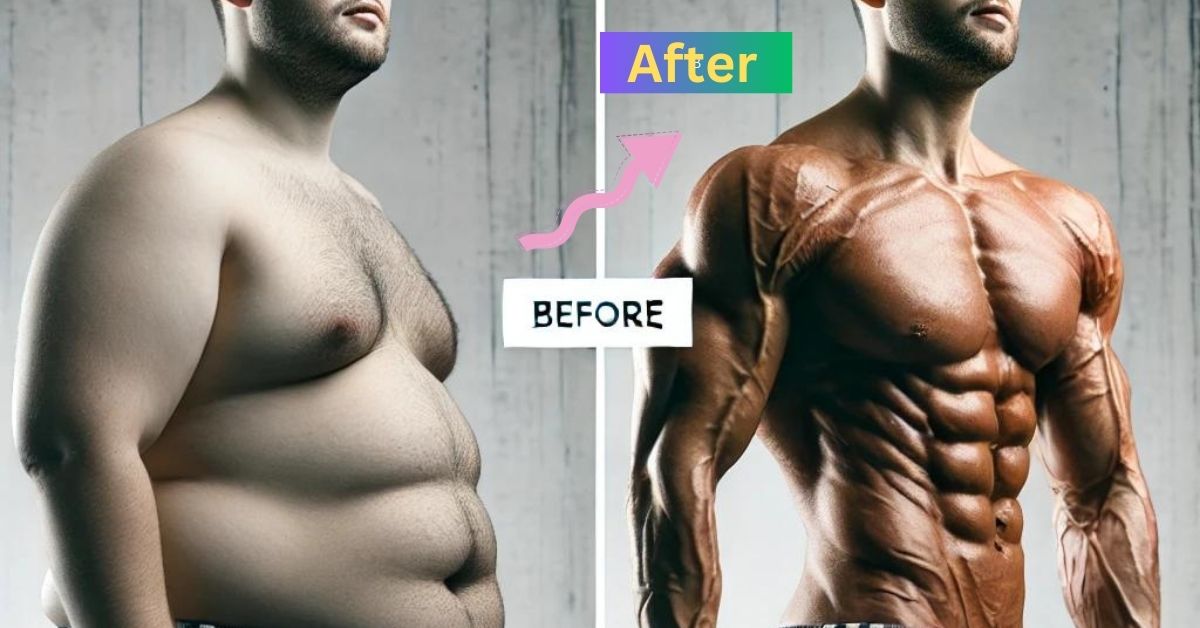Table of Contents
ToggleIntroduction:
A problem often arises in nearly everyone’s life at some point or another- weight gain. However, 50 pounds of weight loss in 6 months is achievable with the right plan that is followed. Nature has its reasons, and we all have weight – some feel less of it, whilst many feel much more. With age, changes in professional or personal life, or just mental stress, a lot of people wish to lose such pounds. There are, however, possibilities, although it might take time. However, the journey does not have to be stressful or bulky.
The purpose of this guide is to help you reach a weight loss of 50 pounds without feeling deprived or restricting your caloric intake. It is necessary to use three essential pillars: diet, physical activity, and mindset. All that matters is having a calorie deficit, exercising, and developing good routines regularly for great results within six months. Prepared to reshape your body as well as your perspective? So, let’s begin.
Creating a Sustainable Calorie Deficit:
The idea of a calorie deficit is perhaps one of the most vital when one seeks to lose weight. When or how does a calorie deficit exist? A calorie deficit exists if fewer calories are consumed than what the body uses to keep its weight. In order to lose 50 pounds in 6 months, you require some form of consistent and attainable deficit that ensures your energy doesn’t drop or that it never feels like you are skipping meals.
Understanding Caloric Needs:
Prior to leaping towards cutting calories, some baseline requirements need to be outlined. Your daily caloric needs can be established based on a number of factors, among them age, gender, weight and activity patterns. There are different calorie calculators available to assist in getting this figure. Once you have these, it becomes easy to cut back so they are all at a deficit.
For instance, if trying to lose 1 pound of weight, one must create a calorie deficit of 3,500. To make 50 pounds of weight loss in six months, one would target 2 pounds of weight loss every week for 6 months, which translates to a balance of 7,000 calories every week. This task may appear very hard, but it is quite easy when you change your strategy to daily targets, for example, making a deficit of roughly 1000 calories less than the maintenance calories a day.
Getting the Right Amount of Calories:
Going on too strict a calorie deficit without professional guidance may backfire in more ways. For instance, eliminating too many calories at the onset may lead to exhaustion and even malnutrition. Moderation is the key, and the changes must be realistic for the long haul. In the following paragraphs are some safe options with which it is possible to decrease the calorie intake:
Portion Control: Instead of cutting out foods, it just makes more sense to cut portion sizes. More frequent, smaller meals and snacks can be interspersed throughout the day to do away with the feeling of hunger.
Swap High-Calorie Foods: Substitute calorically dense items with less calorically endowed substances instead. For instance, water should be taken in place of regular soda or baked foods instead of fried ones.
Incorporate More Fiber: Many vegetables, whole grains, legumes, etc., are high in fibre, which helps you stay full longer and reduces the need to consume excessive food.
Limit Sugary and Processed Foods: Foods with refined sugar and other highly refined diets usually cumulate to a lot of calories without any nutrients. Go for whole foods so that each calorie brings about maximum nutrition.
When you keep decreasing the amounts of calories without depriving yourself of eating various foods, you will be able to keep this deficit for six months without the feeling of constant hunger or being starved.
Incorporating Exercise for Weight Loss:
Encouragement through these methods helps to achieve the target weight because of the activity needed. Having noted the importance of diet-induced weight targets, losing fifty pounds within six months is active, and muscle growth will help lose calories along with the routine. All this will require being active, which involves a lot more than a diet, and regular physical activity is critical to maintaining this weight in the long term.
Strength Training vs. Cardio:
Although strength training and cardiovascular training help in losing weight, each of the two has a different role in the fitness regime.
Cardio: Cardio involves physical exercises that focus mainly on burning fats and everyone’s favourite, the cardiovascular perks. Activities such as changing the speed of the heart rate make these exercises efficient in burning fats in the body. For weight loss purposes, 150-225 minutes of moderate-intensity cardio or 75-150 minutes of vigorous-intensity weekly is recommended. A perfect example includes aerobics like brisk walking, jogging, and running, and then comes more intense variants like HIIT.
Strength Training: Strength training develops lean body mass, which not only shapes your body but also increases your metabolism while you are at rest. The more muscle mass there is, the greater the total energy used even when the body is still. If you want to achieve a well-toned body and still attain fat loss, incorporating two to three sessions of strength training focusing on these compound exercises at least once a week will go far.
Doing both of these resistance and cardiovascular exercises will not only help in losing fat but also in preserving lean body mass, which is a very important factor when trying to lose weight and keep it off long-term.
Exercise Frequency and Intensity:
You can only see changes if you are consistent with your workouts. There is no need to spend all the hours in the gym every day, but developing a more regular pattern of exercising would be ideal. The following is an example of a weight loss exercise plan:
• Cardio: Five days a week, indulge in moderate aerobic exercises for 30-45 minutes each session. This will include activities like cycling, swimming, or jogging, as you would be less tempted to get bored and work on different muscles.
• Strength Training: Carry out strength training workouts at least two to three times weekly, with emphasis on all the main muscle groups. A combination of free weights, resistance bands, and bodyweight exercises will most certainly work the muscles.
High-Intensity Interval Training (HIIT): For people with busy schedules looking to burn drowning calories in the minimal time possible, high-intensity interval training is the approach to take. Add one or two HIIT sessions weekly, where intense exercises are interspersed with very brief breaks.
The bottom line is finding activities you love and can stick to no matter how long it takes. As your body gets used to exercising, step up the intensity or the length of time so that it does not get too comfortable in the routine and stops progressing.
Balancing Nutrition for Optimal Health:
What nutrition entails in the elimination of obesity is a shoulder to lean on. There is more to a weight loss program than just the fewer calories consumed – and that is a proper calorie meal plan to enable weight loss in six months to about 50 pounds. As such, it is important to ensure that a healthy diet includes adequate amounts of all macronutrients and micronutrients over a certain period.
Macronutrients Grazing on Protein, Carbohydrates, and Fats:
Getting the correct amount of protein, carbohydrates, and fat in proportion to the food that you consume will further support the body by preventing you from feeling hungry or binge eating.
Protein: Protein is the core of the weight loss process since it assists in building and sustaining one’s muscles, which re-energizes the body. In other words, aerobic exercise along with some sort of protein diet, like Eggs or chicken breast and even vegetarians can find equivalents in lentils and beans, is more effective in losing weight. Go for at least 20-30 grams of protein per meal to fulfil your hunger and repair yourself from workouts.
Carbohydrates: Not everyone says carbohydrates are bad, healthy, or unhealthy, as there are people who come up with other ideas. Dawning a beautiful day in America is a virtue that is magnificent since the lady suggests that eating white bread, sweet snacks, or any sugary items makes the blood sugar race. People tend to eat excessively than they should, but making use of carbohydrates like quinoa, brown rice, oats, and other types of sweet potatoes acts more helpful. Such carbohydrates are rich in fibre, which is good for digestion and managing one’s appetite.
Fats: These include the healthy fats found in foods such as avocados, olive oil, nuts, and seeds, which are necessary for the well-being of an individual. They make a person feel full and provide the body with many of the fat-soluble vitamins. Add some of the healthy fats in your meals in small quantities to avoid hunger and boost your metabolic level.
Once you manage these macronutrients effectively, you give your body enough energy amounts despite staying within the stipulated calorie figures. This prevents unhealthy food urges, together with the muscle fatigue associated with losing weight.
Choosing Whole Foods Over Processed:
It is well known that whole foods, which are those that are minimally processed or in their natural state, form the foundation of a healthy diet. In contrast, processed foods contain excessive sugar, trans fats, and empty calories that can completely thwart your weight loss efforts.
If it’s not a nutritious meal or snack, then don’t consume it in the first place; go for whole nourishment. Fresh frets, as well as nutritious proteins and grains, will not only fuel your body but also enhance your satiety levels. Here are a few easy changes that you can make to your diet:
• Instead of chips, eat raw vegetables or popcorn.
• Substitute sodas and other sweetened beverages with water or herbal tea.
• White bread and pasta sittings should be substituted with grains and wholemeal.
• Prefer fresh fruits rather than sweets as a dessert.
This trend of sticking primarily to whole foods also has the added benefit of higher nutrient density of calories consumed, hence making it possible to eat fewer calories while still being satisfied and energetic.
Maintaining Long-Term Weight Loss:
There is no doubt that shedding 50 pounds is an incredible milestone. According to statistics, it is the area where most people fail their efforts. The good news is that with the right strategies, one can sustain one’s weight and still embrace healthy living. With a focus on sustainable habits, overcoming adversities such as plateaus, and having the correct mindset, one’s achievements can be kept for many, many years to come.
Avoiding Plateau and Overcoming Obstacles:
During, or towards the end, of your weight loss regimen, there comes a time when you seem to be stuck at a certain weight and do not know how to get around it, even if you try. This is normal and is not uncommon in the course of weight loss periods. Here are some suggestions to get through them:
Change Up Your Exercise Routine: If you’ve been doing the same workout for months, your body may have adapted to the workout. To get through a plateau, change up the routine. Try different forms of workouts, increase the severity of your present workouts, or take up new ones such as swimming, hiking, kickboxing and the like.
Adjust Your Calories: When embarking on an exercise and diet program, the body is likely to lose weight. A caloric intake that worked for you at 200 pounds may not be appropriate when your weight is 150 pounds. You can monitor your weight and the reasons for the changes by using a calorie counter.
Drink lots of Water & Get Enough Rest: There are times when factors not related to diet and exercise cause you to stop losing weight even when you are in a calorie deficit. Make sure you adopt the necessary measures so that your metabolism and general health remain optimal.
Achieving Post-Weight Loss Goals:
If you want to keep the weight loss that you have achieved, you must cope with the lifestyle change that you will be able to maintain forever. It is important to avoid thinking of yourself as losing weight, knowing that it is a project that is due before its deadline. This is because that focus on the project will only last until you reach your goal weight. Below are some of the suggestions on how to form effective habits and stick to them long-term:
Don’t Stop Planning Your Diet: Meal planning is a practice that has been proven to be adequate in preventing weight gain. This is very important since you can take in the right portion without ending up overeating. Adhering to a healthy meal plan does not become boring because there will be a rotating of healthy foods.
Get Moving: You should embrace physical activity for life and make exercise an integral part of your life on a day-to-day basis. Look for activities that you can see yourself taking pleasure in, such as walking, dancing or playing some sport. By making exercise fun, a person is likely to manage it for a longer duration.
Monitor Your Progress: After achieving the desired weight, there is more work to be done, hence the need to keep a record of progress. Weekly or monthly weighing and measurement of one’s body could serve as a motivational practice. However, do concentrate on the other aspects of your body as well, not only the numbers on the scale.
Eat Slowly and Only When Hungry: Eating slowly is the act of starting to eat when a person feels hungry, avoiding larger portions than necessary and avoiding watching television or other distractions. This technique will help in not being over-nagged and having a normalization with the meals.
Seek Ongoing Support: Avoid isolating yourself from your family and friends who are supportive or a group of like-minded individuals. In whichever form – physical or virtual, whether in the context of support groups, fitness classes, or friends with similar aspirations, the motivation snowballs.
Implementing the techniques as mentioned above effectively and combining them with the former practices you used to lose weight will bear fruits, allowing you to prevent regaining weight and continue embracing healthy, active living.
Conclusion:
Reducing weight by 50 pounds in almost six months is a daunting task, but with the right mental attitude and total commitment, such a task can be accomplished. Through consistently taking in fewer calories, a mix of cardio and strength training sessions, adequate nutrition with whole, nutrient-dense foods and regular progress checks, success shall be guaranteed. Let’s keep in mind, though, that weight loss is not only about the number on the scale but rather habits that are cultivated and can last forever.
Even though there will likely be barriers to detect, such as plateaus or self-limiting thoughts, the reason for this is that self-discipline and the relevant changes for the long term will carry the day. Despite each of those goals being attained, do not forget to treat yourself to closure feelings on a journey you make into health and construct impossibly beneficial health. It takes time and dedication, of course, but it is possible to look great and keep it that way for a long time.
FAQs:
How many calories should I take to drop 50 pounds in six months?
One should create a calorie deficit of about 1000 calories every day so that 50 pounds can be lost in six months, which translates into about two pounds of weight loss per week. Going by that equation, the number of calories will depend on the person’s starting weight, frequency of activity, and metabolic rate. Use a calorie counter to get what you ideally should be burning each day, and then scale back accordingly.
What kinds of exercise are the most effective for weight loss of 50 pounds?
To lose weight, it is most successful to do both cardio and strength training. Such exercises include running, cycling or swimming, where the aim is to burn excess calories, while in strength training, the muscles gain mass, and the metabolic rate goes up. One more effective method, when you need to burn lots of calories in a short time quickly, is HIIT – high-intensity interval training.
Is it possible to reduce 50 pounds in just six months without exercising?
There are many reasons diet is important for losing weight, but another significant factor is exercise, which helps to aid weight loss, maintain muscle and other aspects of health. Weight can be lost with diet-based methods, but it is futile as it is not only time-consuming but also does not reshape the body or make the person stronger.
What foods will promote weight loss in a fast and healthy way?
Concentrate on whole, nourishing foods that include good sources of lean protein (such as chicken, fish or tofu), starches (in the form of whole grain and vegetables) and good fats (like avocado, nuts and olive oil). Processed food and sugar snacks or calorie-dense drinks should, in no case, be considered food. It is advisable to eat protein and fibre-abundant meals so that the feelings of hunger come sooner or even trigger less.
How can I break through this weight loss plateau?
In order to break this plateau, try to change your type of training, reduce the amount of food consumed, or include HIIT. This is perfectly normal due to weight loss and the reason for which there is no need to panic if there are changes in food or activity levels after some changes in diet and weight loss efforts have occurred.
How do I keep off the weight I have lost once I have achieved my weight-loss goal?
In order to keep the weight off, you need to continue with the lifestyle changes that you have adopted throughout losing weight. Exercise, balanced nutrition, self-monitoring, and mindful eating should be included. There is a need to put fresh eyes on the goals once in a while, and one should not forget that maintenance is work like weight reduction.











